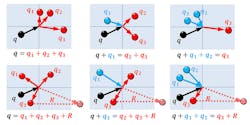New findings overcome a longstanding obstacle in research to understand the effects of heat conduction in solid materials on a quantum level—a critical issue in applications involving heat transfer, energy conversion, and electronics cooling.
The research concerns the crucial role of "phonons," quantum-mechanical phenomena that describe how vibrations travel through a material's crystal structure. The phonons interact, sometimes combining and splitting into new phonons, changing direction and behavior. This “scattering” is fundamental to how materials conduct heat.
Until now, researchers have been able to realistically model only the interactions between three phonons. Recently, however, researchers from Purdue University and Oak Ridge National Laboratory discovered how to accurately model the interactions of four phonons and their effect on heat flow.
“Being able to predict four-phonon scattering has been a decades-long challenge,” says Xiulin Ruan, a Purdue professor of mechanical engineering.
Four-phonon interactions have long been ignored, in part because they were considered to be relatively unimportant and besides, researchers didn’t know how to model them. “Now we have clearly shown the importance of four-phonon scattering.”
Until this discovery, simulating four-phonon scattering required 10,000 times the computational resources as three-phonon scattering, making it unfeasible to perform quality theoretical predictions. However, the Purdue team developed a new method for carrying out the theoretical computations, improving the simulation of four-phonon scattering and reducing the computational resources needed.
These diagrams describe the interactions of four phonons, quantum-mechanical phenomena related to the effects of heat conduction in solid materials. In such “four-phonon interactions,” one phonon splits into three; or two phonons join to form two new phonons; or three phonons combine into one. New research findings have implications for research and various commercial technologies. (Courtesy of Tianli Feng and Xiulin Ruan)
It’s a new way of looking at the physical world, according to Oak Ridge researcher Tianli Feng. “The mechanism of four-phonon scattering was already known, but nobody knew how to make the theoretical predictions or how to assess its importance until we did it.”
Being able to incorporate four-phonon data into calculations will help researchers tailor the thermal conductivity of new materials. Materials that have ultrahigh thermal conductivity are ideal for heat sinks, while those with low thermal conductivity are suited for thermoelectric applications and thermal barrier coatings (i.e., insulators).
The new findings demonstrate that using only three-phonon scattering in calculations overestimates the performance of some materials while underestimating the performance of others.
“The rigorous framework developed by the research team for including four-phonon scattering is novel and of significant scientific importance,” says Alan McGaughey, a professor of mechanical engineering at Carnegie Mellon University. “Their findings shed important light on previous theoretical predictions and experimental measurements, and will help guide developments of new materials for a broad range of applications. Of particular note is the potential to set limits on how high or low thermal conductivity can be across a range of temperatures."
The research, which has been entirely theoretical, can explain previous discrepancies between predicted and experimental thermal conductivities of materials such as silicon at high temperature.
The discovery could aid efforts to improve a host of technologies, including thermoelectric devices, which turn heat into electricity; thermal-barrier coatings such as those used to protect turbine-engine blades from extreme heating; heat sinks for electronics cooling; nuclear fuels; and research into solid-state heat transfer in general.


